 RDL Homepage |
 Table of Contents |
 Document Information |
 Download Instructions |
 RDL Homepage |
 Table of Contents |
 Document Information |
 Download Instructions |
| A swift and vigorous transition to attack-the flashing sword of vengeance-is the most brilliant point of the defensive. |
| Carl von Clausewitz, On War, 1832 |
The mobile defense is a type of defensive operation that concentrates on the destruction or defeat of the enemy through a decisive attack by a striking force (FM 3-0). It focuses on destroying the attacking force by permitting the enemy to advance into a position that exposes him to counterattack and envelopment. The commander holds the majority of his available combat power in a striking force for his decisive operation, a major counterattack. He commits the minimum possible combat power to his fixing force that conducts shaping operations to control the depth and breadth of the enemy's advance. The fixing force also retains the terrain required to conduct the striking force's decisive counterattack. The area defense, on the other hand, focuses on retaining terrain by absorbing the enemy into an interlocked series of positions, where he can be destroyed largely by fires.
10-1. The factors of METT-TC may dictate that a unit conducts a mobile defense when defending against an enemy force with greater combat power but less mobility. A commander may also employ a mobile defense when defending a large area of operations (AO) without well-defined avenues of approach, such as flat, open terrain. The mobile defense is preferred in an environment where the enemy may employ weapons of mass destruction because this type of defense reduces the vulnerability of the force to attack and preserves its freedom of action. Future technology associated with command and control (C2) should improve the ability of the friendly force to gain and maintain a common operational picture, which reduces the risk associated with this type of defense. Among these risks are—
The fixing force may be isolated and defeated in detail because of the need to resource the striking force to the detriment of the fixing force.
Operations in noncontiguous AOs associated with conducting a mobile defense can lead to defeat in detail.
Enemy operations may impair the ability of the striking force to react at critical points.
The enemy may not move into the area intended by the defending commander.
The attacking enemy retains at least some momentum as he approaches the desired engagement areas (EAs).
The defending force may not gain an accurate picture of the enemy's locations and dispositions required by the striking force to launch decisive operations in time to react.
The decentralized operations required by the mobile defense increase the potential for fratricide.
10-2. The concept of a mobile defense did not enter into Army doctrine until it had the chance to review German lessons learned as a result of its World War II experiences in Russia. The following historical example illustrates how conducting a mobile defense can result in recapturing the initiative and accomplishing the mission.
|
10-3. Units smaller than a corps do not normally conduct a mobile defense because of their inability to fight multiple engagements throughout the width, depth, and height of the AO, while simultaneously resourcing striking, fixing, and reserve forces. Typically, the striking force in a mobile defense may consist of one-half to two-thirds of the defender's combat power. (See Figure 10-2.) Division and smaller units generally conduct an area defense or a delay as part of the fixing force as the commander shapes the enemy's penetration or they attack as part of the striking force. Alternatively, they can constitute a portion of the reserve.
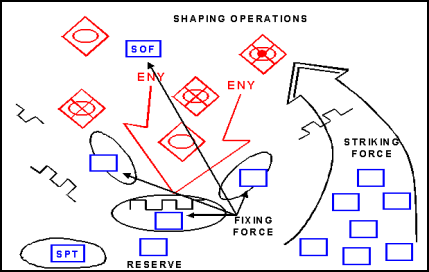
Figure 10-2. Mobile Defense
10-4 The commander organizes his main body into two principal groups-the fixing force and the striking force. In the mobile defense, reconnaissance and security, reserve, and sustaining forces accomplish the same tasks as in an area defense. (See Figure 10-3.) The commander completes any required adjustments in task organization before he commits his units to the fight.
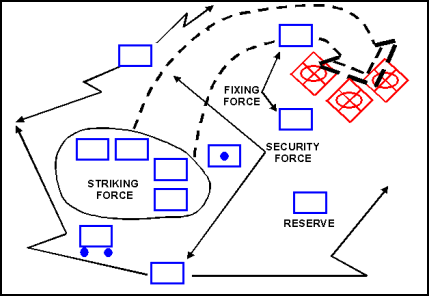
Figure 10-3. Organization of Forces for a Mobile Defense
10-5. Organized by the commander with the minimum combat power needed to accomplish its mission, the fixing force turns, blocks, and delays the attacking enemy force. It tries to shape the enemy penetration or contain his advance. Typically, it has most of the countermobility assets of the defending unit. The fixing force may conduct defensive actions over considerable depth within the main battle area (MBA). However, it must be prepared to stop and hold terrain on short notice to assist the striking force on its commitment. The operations of the fixing force establish the conditions for a decisive attack by the striking force at a favorable tactical location. The fixing force executes its portion of the battle essentially as a combination of an area defense and a delaying action. The actions of the fixing force are shaping operations.
10-6. The striking force decisively engages the enemy as he becomes exposed in his attempts to overcome the fixing force. The term "striking force" is used rather than reserve because the term "reserve" indicates an uncommitted force. The striking force is a committed force and has the resources to conduct a decisive counterattack as part of the mobile defense. It is the commander's decisive operation.
10-7. The striking force contains the maximum combat power available to the commander at the time of its counterattack. The striking force is a combined arms force that has greater combat power and mobility than the force it seeks to defeat or destroy. The commander considers the effects of surprise when determining the relative combat power of the striking force and its targeted enemy unit. The striking force is normally fully task organized with all combat support (CS) and combat service support (CSS) assets before its actual commitment. The commander positions engineer mobility-enhancing assets with the lead elements of the striking force.
10-8. The striking force is the key to a successful mobile defense. All of its contingencies relate to its attack. If the opportunity does not exist to decisively commit the striking force, the defender repositions his forces to establish the conditions for success. The striking force must have mobility equal to or greater than that of its targeted enemy unit. It can obtain this mobility through proper task organization, countermobility operations to slow and disrupt enemy movements, and mobility operations to facilitate the rapid shifting of friendly formations. The striking force requires access to multiple routes because an attacking enemy normally goes to great length to deny the defending force freedom of action.
10-9. The commander responsible for orchestrating the overall mobile defense should retain control of the striking force unless communication difficulties make this impossible. Normally this is the overall defending force commander. The commander's most critical decisions are when, where, and under what conditions he should commit his striking force. The commander normally accompanies the striking force.
10-10. Resourcing a reserve in a mobile defense is difficult and requires the commander to assume risk. He generally uses his reserve to support the fixing force. However, if the reserve is available to the striking force, it exploits the success of the striking force. If the reserve is composed largely of aviation forces and long-range fire support systems, it may have contingencies to support the fixing and striking forces.
10-11. A commander conducting a mobile defense uses control measures to synchronize conducting the operation. These control measures include designating the AOs of the fixing and striking forces with their associated boundaries, battle positions, and phase lines. He designates a line of departure or a line of contact as part of the graphic control measures for the striking force. He may designate an axis of advance for the striking force. He can designate attack-by-fire or support-by-fire positions. The commander uses EAs, target reference points, targeted areas of interest, and final protective fires as necessary. He designates named areas of interest to focus the efforts of his intelligence, surveillance, and reconnaissance (ISR) assets. This allows him to determine the enemy's course of action (COA). He designates checkpoints, contact points, passage points, passage routes, and passage lanes for use by reconnaissance and surveillance assets, security units, and the striking force. (See Figure 10-4.)
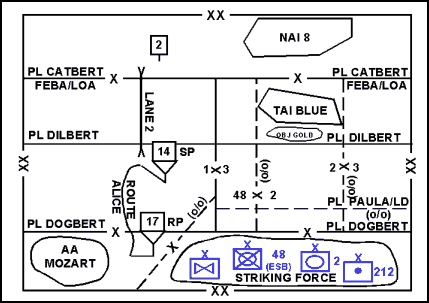
Figure 10-4. Mobile Defense Control Measures
10-12. The commander must provide the striking force commander with control measures to focus his force at the decisive time and place and to deconflict fires with the fixing force. As a minimum, the striking force commander needs to know the anticipated objective decision points that could lead to the commitment of his force, limit of advance, and boundaries of his AO. If the overall commander imposes either an axis of attack or a direction of attack as a control measure, he restricts the striking force commander's freedom of maneuver. However, such restrictions may be necessary to avoid contact with enemy forces that could distract the striking force from accomplishing its primary mission. These control measures may have to be drawn "on the fly" while the commander, his staff, and his subordinates move to take advantage of an opportunity to commit the striking force in a decisive counterattack. They should also help the commander recover the integrity of his defense if the striking force is not successful in its attack. (Chapters 2, 5, and 8 explain these control measures.)
10-13. The key to successful mobile defensive operations is the integration and synchronization of all available assets to maximize the combat power of the defending unit, particularly the striking force. The commander achieves integration and synchronization when he can employ their combined effects at decisive times and places. (The general defensive planning considerations addressed in Chapter 8 apply to the mobile defense.)
10-14. The commander's ability to maintain the mobility advantage of his forces is an important aspect of the mobile defense. This mobility advantage may result from or be enhanced by countermobility actions directed against the enemy force. In his mobile defense plan, the commander ensures that his forces-including reserves and the striking force-can move freely around the battlefield, while at the same time restricting the enemy's mobility, slowing his momentum, and guiding or forcing him into areas that favor the friendly defensive effort.
10-15. The effectiveness of a mobile defense is based on the carefully planned fires of all weapons. The striking force conducts the commander's decisive operation in a mobile defense. It requires continuous and concentrated fire support. The commander weights his decisive operation, in part, by allocating to it field artillery and other fire support weapon systems. He must rapidly shift indirect fire support from the fixing force to the striking force. These fire support systems do not have to move with the striking force if it remains within supporting range.
10-16. If the striking force's planned maneuver places it outside the supporting range of the defending commander's fire support systems, he must either plan the movement of fire support assets to locations where they can support the striking force or incorporate them into the striking force. Fire support assets can partially compensate for a lack of maneuver forces in the striking force. The commander takes precautions to prevent fratricide as the striking force approaches the fixing force's EAs, while supporting air and artillery assets try to interdict enemy movements.
10-17. In the mobile defense, air defense is normally initially used to cover—
Security forces and fixing force units in forward areas.
C2 facilities.
Critical assets, including fire support systems, reserves, and the striking force.
Sustainment resources.
Choke points along movement corridors planned for use by reserves or the striking force.
Once the commander commits the striking force, it receives priority of support as the decisive operation. If the striking force attacks to extended depths, the commander ensures that it and other critical assets remain within the coverage of available air defense systems. This may require him to reposition air defense radars and systems to maintain air defense coverage of the defending force.
10-18. The majority of the commander's countermobility and survivability assets support the operations of the fixing force. The majority of the commander's mobility assets support the operations of the striking force. Situational obstacles provide him a tremendous advantage in the mobile defense. These obstacles are a combat multiplier because they enable the commander to use economy of force measures. He uses situational obstacles to exploit enemy vulnerabilities, exploit success, separate enemy follow-on forces, and provide flank protection.
10-19. When planning for the mobile defense's sustaining operations, logistics operations planners must look beyond the fixing force's shaping operations to prepare to support the striking force's decisive counterattack. The greater the distance the striking force must cover when moving from its assembly area (AA) to its final objective, the greater the amount of supplies needed to support that move. Once committed, units in the striking force require priority of fuel, ammunition, and maintenance support over comparable units in the fixing force. Casualty evacuation will be a challenge because the fixing force will likely suffer a higher percentage of casualties but the lines of communications to the striking force must also support casualty treatment and evacuation. When the striking force must move a considerable distance from its sustaining base, the commander should consider establishing an intermediate support base (ISB). Before establishing an ISB, he must weigh the benefits of establishing the base against the cost in terms of combat power or effort diverted from the support mission to secure the ISB.
10-20. Preparations for conducting a mobile defense include developing the fixing force's defensive positions and EAs as discussed in Chapter 8. The commander aggressively uses his reconnaissance assets to track enemy units as they approach. Engineers participate in conducting route and area reconnaissance to find and classify existing routes. They improve existing routes and open new routes for use during the battle.
10-21. The striking force assembles in one or more areas depending on the width of the AO, the terrain, enemy capabilities, and the planned manner of employment. Before the enemy attack begins, the striking force may deploy all or some of its elements forward in the MBA to—
Deceive the enemy regarding the purpose of the force.
Occupy dummy battle positions.
Create a false impression of unit boundaries, which is important when operating with a mix of heavy and light forces or multinational forces.
Conduct reconnaissance of routes between the striking force's AAs and potential EAs.
10-22. The enemy attempts to discover the strength, composition, and location of the units that constitute the fixing force and the striking force. The commander uses security forces and information operations to deny the enemy this information and degrade the collection capabilities of enemy ISR assets. The commander routinely repositions to mislead the enemy and to protect his force. In addition, his plans and preparations incorporate defensive information operations. The commander normally tries to portray an area defense while hiding the existence and location of the striking force.
10-23. This manual divides the execution of a mobile defense into five phases for discussion purposes. The length and nature of each phase, if it occurs at all, varies from situation to situation according to the factors of METT-TC. The phases of defensive operations are gain and maintain enemy contact, disrupt the enemy, fix the enemy, maneuver, and follow through.
10-24. The commander must have the flexibility to yield terrain and shape the enemy penetration. He may even entice the enemy by appearing to uncover an objective of strategic or operational value to the enemy. The striking force conducts the decisive operation-the attack-once the results of the actions of the fixing force meet the commander's intent.
10-25. The commander conducting a mobile defense focuses on discovering the exact location of the enemy and his strength to facilitate the effectiveness of the striking force. The security force (guard or cover) or the fixing force confirms the enemy's COA and main avenues of approach. The commander normally tasks other ISR assets to determine the location of enemy reserves and follow-on forces. Early detection of the enemy's decisive operation provides the commander with reaction time to adjust the fixing force's positions and shape the enemy penetration, which, in turn, provides the time necessary to commit the striking force. The striking force commander requires as close to real-time updates of the enemy situation as are possible to ensure that the striking force engages the enemy at the right location and time.
10-26. While conducting operations, the security force determines what routes the enemy is using, where the enemy is strong or weak, and where gaps in and between enemy formations exist. This information aids the commander in his attempt to seize the initiative. That information also increases the striking force's agility by identifying opportunities. Further, it helps pull the striking force along the path of least resistance as it maneuvers to employ its combat power at the critical time and place.
10-27. In a mobile defense, the commander conducts shaping operations designed to shape the enemy's penetration into the MBA and disrupt the enemy's introduction of fresh forces into the fight. These shaping operations help establish the preconditions for committing the striking force by isolating the object of the striking force and destroying the enemy's key C2 nodes, logistics resupply units, and reserves. Whenever possible the commander sequences these shaping operations, to include offensive information operations, so that the impact of their effects coincides with the commitment of the striking force. To generate a tempo that temporarily paralyzes enemy C2, the intensity of these shaping operations may increase dramatically on the commitment of the striking force. The commander continues to conduct shaping operations once the striking force commits to prevent enemy forces from outside the objective area from interfering with executing the decisive counterattack.
10-28. Fixing the enemy is the second half of shaping operations and results in establishing the conditions necessary for decisive operations by the striking force. Typically, the commander of the defending force allows the enemy force to penetrate into the defensive AO before the striking force attacks. (See Figure 10-5.) The fixing force may employ a combination of area defense, delay, and strong point defensive techniques to shape the enemy penetration. The intent of the fixing force is not necessarily to defeat the enemy but to shape the penetration to facilitate a decisive counterattack by the striking force. The commander ensures that the missions and task organization of subordinate units within the fixing force are consistent with his concept for shaping the enemy penetration. Defensive positions within the fixing force may not be contiguous since the fixing force contains only the minimum-essential combat power to accomplish its mission.
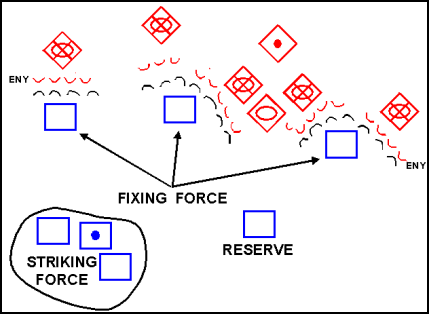
Figure 10-5. Mobile Defense Before Commitment of Striking Force
10-29. The fixing force's extensive use of obstacles supports this shaping effort and helps to gain an overall mobility advantage over the enemy. The commander may want to yield ground quickly to make the enemy think he has been successful or to entice him to a decisive point where the striking force can attack. Normally, in a mobile defense, the commander retains ground only to facilitate the commitment of his striking force.
10-30. When conducting a mobile defense, the commander may need to commit his reserve to reinforce the fixing force and help shape the battlefield. He positions his reserve so it effectively reacts to the most likely contingency and the enemy's most dangerous COA. Without a reserve, the commander assumes significant risk in attempting to shape the enemy penetration. Circumstances may also force the commander to employ elements of the striking force to assist the fixing force. If that occurs, the commander prefers to use his available long-range fire support assets and attack helicopters. They are the best choice because of their ability to rapidly disengage and shift their effects to support the efforts of the rest of the striking force on its commitment.
10-31. The commander's situational understanding is critical in establishing the conditions that initiate the striking force's movement and in determining the general area that serves as a focus for the counterattack. Situational understanding includes identifying those points in time and space where the counterattack proves decisive. A force-oriented objective or an EA usually indicates the decisive point. The staff synchronizes the unit's activities in time and space to sufficiently mass the effects of the striking force at the right time and place.
10-32. The actions of the striking force are the echelon's decisive operation on its commitment. The commander's ISR systems focus entirely on tracking the enemy's advance. The striking force commander continuously receives intelligence and combat information updates that allow him to adjust his counterattack as necessary to defeat the targeted enemy. Once the enemy starts his attack, any forward-deployed elements of the striking force withdraw to AAs or attack positions and prepare for their commitment in counterattack.
10-33. The defending commander launches his striking force in a counterattack when its offensive power, relative to that of the targeted attacking enemy element, is the greatest. (See Figure 10-6.) Piecemeal commitment of the striking force in support of local objectives jeopardizes the success of the overall operation. The striking force must execute the counterattack rapidly and violently, employing all combat power necessary to ensure success. The striking force may be committed at a time different than anticipated and in an entirely different area than previous contingency plans envisioned. Thus, it must be able to respond to unexpected developments rapidly and decisively.
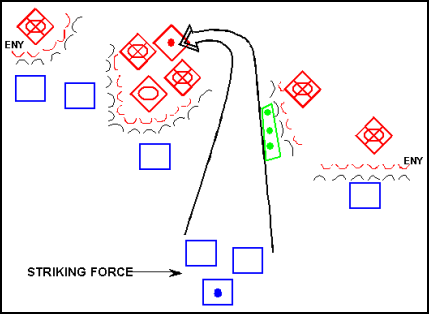
Figure 10-6. Mobile Defense After Commitment of Striking Force
10-34. Because the striking force normally attacks a moving enemy force, it generally assumes a combat formation with a covering force, an advance guard, a main body, and either a follow-and-support or a follow-and-assume force. The striking force attempts to take advantage of obstacles, such as rivers or obstacle zones that block the enemy's movement. The commander designates flank responsibilities and may even allocate a designated force against a particularly vulnerable flank. However, the striking force moves quickly and takes risk on its flanks, using its speed of movement and superior situational understanding to provide security.
10-35. The striking force attacks in a formation that provides maximum combat power forward to devastate the targeted enemy force and achieve decisive results. The striking force takes advantage of its mobility and fire power to seize the initiative by overwhelming the enemy force with swift, violent blows that cripple the enemy's command and control system, disrupt his formations, and destroy his combat systems. The commander ensures that his fire support and fixing force capture the enemy's attention and posture the enemy for attack by the striking force. During the counterattack, he may have one element of the striking force occupy support-by-fire positions to suppress the enemy, while another striking force element prepares to assault the objective. Either heavy or light forces may make this assault. (Chapter 5 discusses the actual conduct of an assault on an objective.)
10-36. Engineers should be well forward to enhance the mobility of the striking force. These lead engineers search for existing obstacles and clear the route as much as possible within their capabilities. Follow-on engineers expand breaches, improve routes, and replace assault bridges with more permanent structures. Engineers with flank units focus on countermobility to protect the flanks.
10-37. All defensive operations intend to create the opportunity to transition to the offense. In a mobile defense, that transitional opportunity generally results from the success of the striking force's attack. The commander exploits his success and attempts to establish conditions for a pursuit if his assessment of the striking force's attack is that there are opportunities for future offensive operations. (Chapters 6 and 7 discuss exploitation and pursuit.) If conducting the mobile defense is unsuccessful and the enemy retains the initiative, the commander must either reestablish a viable defense or conduct retrograde operations. (Retrograde operations are the topic of Chapter 11.)